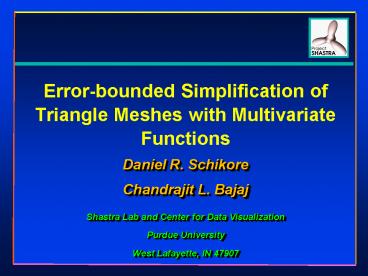Errorbounded Simplification of Triangle Meshes with Multivariate Functions - PowerPoint PPT Presentation
1 / 36
Title:
Errorbounded Simplification of Triangle Meshes with Multivariate Functions
Description:
Error-bounded Simplification of Triangle Meshes with Multivariate Functions ... Close-up of the above. Topology of wind speed in a climate model simulation ... – PowerPoint PPT presentation
Number of Views:53
Avg rating:3.0/5.0
Title: Errorbounded Simplification of Triangle Meshes with Multivariate Functions
1
Error-bounded Simplification of Triangle Meshes
with Multivariate Functions
- Daniel R. Schikore
- Chandrajit L. Bajaj
Shastra Lab and Center for Data
Visualization Purdue University West Lafayette,
IN 47907
2
Outline
- Background
- Problem Definition
- Related Work
- Outline of Algorithm
- Results
- Additional Applications
- Future Work
3
Interrogative Visualization
Data Synthesis Computation
Workstation
Workstation
Servers
Display, Querying Analysis
Domain Data Acquisition
4
Mesh Simplification
- Input Mesh Functions defined on mesh Bounds
on error in geometry and functions - Output Simplified mesh within specified error
constraints
5
Problem Definition
- Original mesh Simplified
approximation
6
Problem Definition
- Original mesh Simplified
approximation
7
Related Work
- Geometric Simplification - Point/Edge/Triangle
Deletion (Cohen et al., Hamann, Rossignac et
al., Schroeder et al.) Energy Optimization
(Hoppe et al., Turk) Resampling (He et
al.) Multiresolution (Certain et al., Eck et
al.) Quadtree (Lindstrom et al.) - Data Simplification - Point Insertion/Deletion
(DeFloriani et al., Fowler et al., Lee, Puppo
et. al, Silva et al., Tsai, Ware et al.)
8
Point Deletion/Insertion
9
Algorithm Outline
- Consider each vertex v for deletion
- Compute a triangulation of the neighbors of
vertex v - Determine mapping between triangulations
- Iteratively attempt to improve triangulation
(reduce error) by edge-flipping - Delete v if error criteria are satisfied
10
Vertex Classification
Interior Vertex
- Edge Vertex
11
Mapping Between Triangulations
- Projection of New
- Triangulation
Interior Vertex
12
Mapping Between Triangulations
- Projection of New
- Triangulation
Edge Vertex
13
Error Propagation
- Projection of New
- Triangulation
Segmentation
14
Error Representation
- Two error values per face - Easy to update
- Combines information about all deleted
vertices
15
Updating Errors
Vj
p
Vi
Vj
p
Vi
- Error bound in Original Triangulation
- Cumulative Error Bound to Edge from Vi to Vj
16
Computing Geometric Error
- Geometric error is quantified by the signed
distance from the old triangulation to the new
triangulation - Displacement in the direction of normal is
positive error by convention
17
Computing Data Errors
- Errors in data are quantified by the signed
difference between interpolated data values in
the old and new triangulations
18
Retriangulation
- Initial triangulation is arbitrary
- Cost of an edge may be computed as a) Maximum
error in geometry or data b) Maximum error
introduced in geometry or data - Edges are flipped if cost of the flipped edge
is lower than the cost of the current edge
19
Results
20
Pion Collision
12 functions, 51 timesteps
3 Error (60-85 reduced)
Data Courtesy Lawrence Livermore National
Laboratory
21
Heart MRI
Original Data (256x256)
6 Error (85 reduced, 19460 tri)
Data Courtesy Tsuyoshi Yamamoto and Hiroyuki
Fukuda, Hokkaido University
22
Austin DEM
Original Data (1201x1201)
6 Error (96 reduced, 125K tri)
Data Courtesy US Geological Survey
23
Projectile Impact
Original Data (2869 tri)
3 Error (1356 tri)
Data Courtesy Lawrence Livermore National
Laboratory
24
Projectile Impact
Original Data (2869 tri)
3 Error (1356 tri)
Data Courtesy Lawrence Livermore National
Laboratory
25
Earth Science Data
Original Data (4846 tri)
3 Error (2384 tri)
Data Courtesy Space Science and Engineering Center
26
Earth Science Data
Original Data (4846 tri)
3 Error (2384 tri)
Data Courtesy Space Science and Engineering Center
27
Isosurface of Visible Woman
Original Data (275,048 tri)
3 Error (24,211 tri)
Data Courtesy National Library of Medicine
28
Application Scattered Data Fitting
Triangle mesh
Points
Reduced mesh
Smooth model
3D Delaunay tri. and ??solid
Mesh reduction
A-patch fitting
29
Phase 1 ?-solid
Build an interpolating triangle mesh from the
points. Technique inspired by ??shapes??Edelsbrunn
er?????and 3D Delaunay triangulation sculpturing
Boissonnat 84
- Three steps
- Compute the 3D Delaunay triangulation
- Extract a subset of tetrahedra whose boundary is
a closed two-manifold that best approximates the
points - Remove additional tetrahedra until all points on
boundary
30
Phase 2 Mesh reduction
- Based on incremental deletion of vertices and
retriangulation - Guaranteed, global error-bound
- Sharp feature recognition and preservation
- Mesh reduction technique for triangle meshes with
multivariate data Bajaj, Schikore 96
31
Phase 3 Surface Fitting
- Uses cubic A-patches (algebraic patches)
- C1 continuity
- Sharp features (corners, sharp curved edges)
- Singularities
32
Example
33
Example
34
Conclusions
- Fast Error-bounded Simplification of Planar
and Surface Meshes - Multiple Scalar Functions
35
Scalar Field Topology
Topology of wind speed in a climate model
simulation
Topology of a scalar field
Topology of a mathematical function reveals
information hidden in contour display
Close-up of the above
36
Future Work
- Improved measures of error (Linear/ Quadratic
fitting) - Better initial triangulation
- Simulated annealing in edge flipping and
vertex removal - Different norms for error vector
- Time domain simplification
- Surface normal consideration































